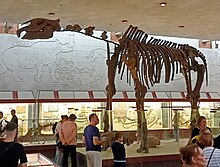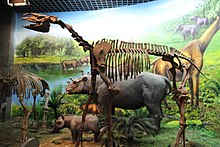The Oligocene is a geologic epoch of the Paleogene Period and extends from about 33.9 million to 23 million years before the present. As with other older geologic periods, the rock beds that define the epoch are well identified but the exact dates of the start and end of the epoch are slightly uncertain. The name Oligocene was coined in 1854 by the German paleontologist Heinrich Ernst Beyrich from his studies of marine beds in Belgium and Germany. The name comes from the Ancient Greek ὀλίγος and καινός, and refers to the sparsity of extant forms of molluscs. The Oligocene is preceded by the Eocene Epoch and is followed by the Miocene Epoch. The Oligocene is the third and final epoch of the Paleogene Period.

Perissodactyla is an order of ungulates. The order includes about 17 living species divided into three families: Equidae, Rhinocerotidae (rhinoceroses), and Tapiridae (tapirs). They typically have reduced the weight-bearing toes to three or one of the five original toes, though tapirs retain four toes on their front feet. The nonweight-bearing toes are either present, absent, vestigial, or positioned posteriorly. By contrast, artiodactyls bear most of their weight equally on four or two of the five toes: their third and fourth toes. Another difference between the two is that perissodactyls digest plant cellulose in their intestines, rather than in one or more stomach chambers as artiodactyls, with the exception of Suina, do.
The Phanerozoic is the current and the latest of the four geologic eons in the Earth's geologic time scale, covering the time period from 538.8 million years ago to the present. It is the eon during which abundant animal and plant life has proliferated, diversified and colonized various niches on the Earth's surface, beginning with the Cambrian period when animals first developed hard shells that can be clearly preserved in the fossil record. The time before the Phanerozoic, collectively called the Precambrian, is now divided into the Hadean, Archaean and Proterozoic eons.

A rhinoceros, commonly abbreviated to rhino, is a member of any of the five extant species of odd-toed ungulates in the family Rhinocerotidae; it can also refer to a member of any of the extinct species of the superfamily Rhinocerotoidea. Two of the extant species are native to Africa, and three to South and Southeast Asia.

Paraceratherium is an extinct genus of hornless rhinocerotoids belonging to the family Paraceratheriidae. It is one of the largest terrestrial mammals that has ever existed and lived from the early to late Oligocene epoch. The first fossils were discovered in what is now Pakistan, and remains have been found across Eurasia between China and the Balkans. Paraceratherium means "near the hornless beast", in reference to Aceratherium, the genus in which the type species P. bugtiense was originally placed.

Sirenia is the order of placental mammals which comprises modern "sea cows" and their extinct relatives. They are the only extant herbivorous marine mammals and the only group of herbivorous mammals to have become completely aquatic. Sirenians are thought to have a 50-million-year-old fossil record. They attained modest diversity during the Oligocene and Miocene, but have since declined as a result of climatic cooling, oceanographic changes, and human interference. Two genera and four species are extant: Trichechus, which includes the three species of manatee that live along the Atlantic coasts and in rivers and coastlines of the Americas and western Africa, and Dugong, which is found in the Indian and Pacific oceans.
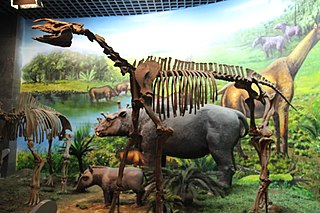
Juxia, ‘joo-she-a’, is an extinct genus of paraceratheriid, a group of herbivorous mammals that are related to the modern rhinoceros. The type species is Juxia sharamurenensis, named by Zhou Mingzhen and Qiu Zhanxiang in 1964. Juxia was around the size of a horse. It lived in Asia during the upper Eocene.

Rhinocerotoidea is a superfamily consisting of five families of odd-toed ungulates, four of which, the Amynodontidae, Hyracodontidae, Paraceratheriidae and Eggysodontidae, are extinct. The only extant family is the Rhinocerotidae, which survives as five living species. Extinct non-rhinocerotid members of the group are sometimes considered rhinoceroses in a broad sense. The family Paraceratheriidae contains the largest land mammals known to have ever existed.
Deng Tao is a Chinese palaeontologist at the Institute of Vertebrate Paleontology and Paleoanthropology (IVPP), Chinese Academy of Sciences, who has made important fossil discoveries on Cenozoic mammals. He is a professor of vertebrate palaeontology, deputy director of the Academic Committee, and deputy director of Key Laboratory of Evolutionary Systematics of Vertebrates at IVPP.
Eggysodon is an extinct genus of odd-toed ungulate belong to the rhinoceros-like family Eggysodontidae. It was a small, ground-dwelling browser, and fossils have been found in Oligocene deposits throughout Europe. Eggysodon may have been related to Preaceratherium, and both had tusklike canines and smaller, and fewer, incisors.
Eggysodontidae is a family of perissodactyls closely related to rhinoceroses. Fossils have been found in Oligocene deposits in Europe, the Caucasus, Central Asia, China, and Mongolia.
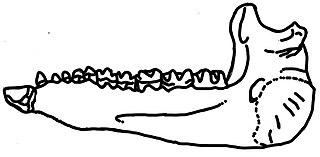
Urtinotherium is an extinct genus of paracerathere mammals. It was a large animal that was closely related to Paraceratherium, and found in rocks dating from the Late Eocene to Early Oligocene period. The remains were first discovered in the Urtyn Obo region in Inner Mongolia, which the name Urtinotherium is based upon. Other referred specimens are from northern China.

Forstercooperia is an extinct genus of forstercooperiine paraceratheriid rhinocerotoids from the Middle Eocene of Asia.
This paleomammalogy list records new fossil mammal taxa that were described during the year 2011, as well as notes other significant paleomammalogy discoveries and events which occurred during that year.
This paleomammalogy list records new fossil mammal taxa that were described during the year 2016, as well as notes other significant paleomammalogy discoveries and events which occurred during that year.
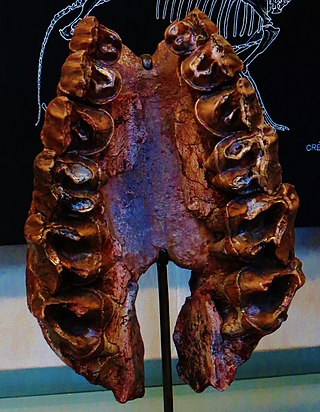
Ronzotherium is an extinct genus of perissodactyl mammal from the family Rhinocerotidae. The name derives from the hill of 'Ronzon', the French locality near Le Puy-en-Velay at which it was first discovered, and the Greek suffix 'therium' meaning 'beast'. At present 5 species have been identified from several localities in Europe and Asia, spanning the Late Eocene to Upper Oligocene.

Pappaceras is an extinct genus of rhinocerotoids from the Early Eocene of Asia belonging to Paraceratheriidae.

Dzungariotherium is a genus of paraceratheriid, an extinct group of large, hornless rhinocerotoids, which lived during the middle and late Oligocene of northwest China. The type species D. orgosense was described in 1973 based on fossils—mainly teeth—from Dzungaria in Xinjiang, northwest China.
This paleomammalogy list records new fossil mammal taxa that were described during the year 2020, as well as notes other significant paleomammalogy discoveries and events which occurred during the year.

Uintaceras is an extinct genus of medium-sized early rhinocerotoids that lived in North America during the Middle Eocene, with only the type species U. radinskyi, named in 1997, currently contained within the genus. Traditionally considered the oldest and most primitive species of the Rhinocerotidae, it may instead have been a close relative of the Asian Paraceratheriidae. The dubious species Forstercooperia (Hyrachyus) grandis is also possibly the same animal as Uintaceras, although the Asian material of F. grandis was assignable to Forstercooperia confluens.
